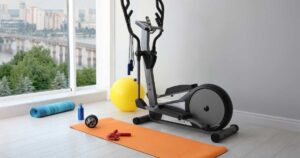6 Must-Try Exercises that Start with C (How To Perform, Tips, Intensity level, Muscles Worked, Average Calorie Burn, Safety precautions)
Exercise is essential to our bodies and minds, yet many fail to engage in regular exercises; those who do often become tired of repeating the same routine every day.
So, to accommodate this, we’re starting a series that offers fun and challenging exercises related to every letter in the alphabet – to keep your fitness journey engaging!
Cobra Fitness presents six exercises beginning with “C”. These will target various muscle groups, provide various intensity levels, and burn an average number of calories to help reach your fitness goals.
Let’s get moving and add these exciting and effective exercises starting with “C” to our fitness regimen!
6 Must-Try Exercises that Start with C
- Crossover Lunges
- Calf Raises
- Crunches
- Cobra Stretch
- Crab Toe Touches
- Cat-Cow
Crossover Lunges
Crossover lunges are an effective exercise to strengthen glutes, quads and hamstrings while simultaneously improving balance and coordination.
This can also strengthen core muscles and increase hip mobility while correcting any muscular imbalances between both sides of your body.
How to do Crossover Lunges:
- Stand with your feet shoulder-width apart.
- Take a big step diagonally behind you with your left leg, crossing it behind your right leg.
- Lower your body until your left thigh is parallel to the ground, keeping your right knee bent at a 90-degree angle.
- Push off with your left foot to return to the starting position.
- Repeat on the other side, crossing your right leg behind your left leg.
Tips:
- Keep your chest up and shoulders back throughout the movement.
- Make sure to engage your core for stability.
- Keep your front knee in line with your ankle to avoid any strain on the knee joint.
- Hold weights in each hand to increase difficulty or use a resistance band around your thighs.
Intensity level:
Moderate to high intensity. The difficulty level can be increased by adding weights or increasing the speed of the movement.
SEE ALSO: 5 OVERHEAD EXERCISES THAT START WITH O
Muscles Worked:
- Glutes
- Quadriceps
- Hamstrings
- Inner and outer thighs (adductors and abductors)
- Calves
Average Calorie Burn:
The average calorie burn for performing crossover lunges depends on factors such as your weight, intensity level, and duration of the exercise.
On average, a person weighing 150 pounds can burn approximately 100-150 calories in a 10-minute session.
Safety precautions for performing Crossover Lunges:
- Make sure to warm up your muscles before attempting crossover lunges to prevent injury.
- Make sure you have enough space around you to perform these exercises that start with C.
Calf Raises
Calf raises are designed to target two specific muscle groups in your calf: gastrocnemius and soleus muscles. Regularly performing this exercise will strengthen and tone these muscles for more defined and shapely calves.
Calf raises are an effective way to enhance balance and stability as well as protect against injuries to the lower legs. Furthermore, adding them into your workout regimen will improve ankle mobility and flexibility.
How to do Calf Raises:
- Stand with your feet hip-width apart, toes facing forward.
- Engage your core and keep your shoulders relaxed.
- Slowly lift your heels off the ground, pushing through the balls of your feet.
- Pause for a second at the top and then lower your heels back to the ground.
- Repeat for the desired number of repetitions.
Tips:
- Keep your movements controlled and avoid bouncing.
- To increase the intensity, try holding weights in each hand or standing on a step for an added challenge.
- Make sure to keep your knees straight and aligned with your toes throughout the exercise.
- Aim for 3 sets of 12-15 reps for optimal results.
- Remember to stretch your calves after completing the exercise to prevent tightness and soreness.
Intensity level:
Calf raises are considered beginner/intermediate intensity exercises, meaning they pose no difficulty to those just beginning strength training in their routines. While challenging, this exercise remains suitable for novice strength trainers.
As you become more proficient with your movement, gradually increase the intensity by holding weights or performing single-leg calf raises with one leg raised. However, make sure that you listen to what your body needs in terms of intensity to avoid injury.
Muscles Worked:
- The main muscle worked in this exercise that starts with c is the gastrocnemius, which is the largest and most visible muscle in the calf.
- The soleus, a smaller muscle underneath the gastrocnemius, also plays a role in calf raises.
- These two muscles work together to help you rise onto your toes and maintain balance.
- In addition to the calves, calf raises also engage other muscles such as the quadriceps, glutes, and core for stabilization.
SEE ALSO: 5 MUST-TRY EXERCISES THAT START WITH D
Average Calorie Burn:
The average calorie burn for a person weighing 155 pounds doing calf raises for 30 minutes is approximately 186 calories.
However, the exact number of calories burned may vary depending on factors such as weight, intensity, and effort put into the exercise.
Safety precautions for performing Calf Raises:
- Before jumping into calf raises, make sure to warm up your muscles with some light cardio or dynamic stretches. This will help prepare your muscles for the workout and reduce the risk of injury.
- It is crucial to maintain proper form while doing calf raises to avoid straining your muscles. Keep your back straight and core engaged throughout the exercise. Also, make sure not to lock your knees as this can put unnecessary pressure on them.
- If you are new to calf raises, start with a lower number of repetitions and gradually increase as you build strength.
- It may be tempting to use momentum while doing calf raises, but this can lead to injury. Make sure to control your movements and avoid bouncing up and down during these exercises that start with C.
Crunches
Crunches primarily target the abdominal muscles, including the rectus abdominis, obliques, and transverse abdominis. These muscles are responsible for stabilizing the spine and supporting good posture.
How to do Crunches:
- Lie on your back with your knees bent and feet flat on the ground.
- Place your hands behind your head or crossed over your chest.
- Engage your core and lift your shoulders off the ground, bringing your chest towards your knees.
- Hold for a second at the top, then slowly lower back down.
- Repeat for several reps, making sure to keep your neck relaxed and avoid pulling on it with your hands.
Tips:
- Make sure to keep your abdominal muscles tight throughout the entire movement.
- Place your hands lightly behind your head, keeping your elbows wide and avoiding pulling on your neck. Keep your chin up and focus on lifting with your abs, not with your head or neck.
- Avoid swinging or jerking motions, as this can put a strain on your back and neck. Instead, focus on slow and controlled movements to fully engage the targeted muscles.
- Remember to exhale as you crunch up and inhale as you release back down to the starting position.
- If regular crunches are too challenging, start with modified versions such as reverse crunches or bicycle crunches until you build enough strength to do traditional crunches.
Intensity level:
Crunches can be modified to fit different intensity levels. To increase the intensity, you can hold a weight or medicine ball against your chest while performing the crunches.
You can also try different variations such as bicycle crunches or reverse crunches to challenge your core muscles even more. To decrease the intensity, you can perform the crunches with your feet on the ground and knees bent at a 90-degree angle, making it easier to lift your upper body off the ground.
Muscles Worked:
- Crunches primarily target the rectus abdominis, or the “six-pack” muscles.
- They also engage the obliques and other core muscles for stability and support.
- they also target other muscles in the body, such as the hip flexors, chest muscles (pectoralis major), and the lower back muscles (erector spinae).
Average Calorie Burn:
The exact number of calories burned by crunches depends on factors such as your weight, intensity level, and duration of exercise. Crunches burn around three to four calories per minute. It is possible to increase your calorie burn by doing variations such as bicycle crunches or reverse crunches.
Safety precautions for performing Crunches:
- Avoid pulling on your neck with your hands throughout the exercise.
- Don’t push through any pain in your lower backstop if you feel uncomfortable.
- Engage your core muscles throughout the exercise to prevent strain and support your back.
- Consult with a medical professional if you have any pre-existing back or neck injuries.
Cobra Stretch
The cobra stretch is an effective way to stretch the muscles in your back, chest, and shoulders, which can help improve overall flexibility and range of motion.
How to do Cobra Stretch:
- Begin by lying face down on a mat or comfortable surface.
- Place your palms flat on the ground next to your chest, with your elbows bent and tucked close to your sides.
- Slowly push through your palms to lift your chest off the ground, keeping your hips and legs firmly on the ground.
- Hold this position for 10-15 seconds, feeling a stretch in your abdominal muscles and lower back.
- Repeat for several repetitions, gradually increasing the duration of each hold.
Tips:
- To deepen the stretch, try straightening out your arms and lifting your chin towards the ceiling.
- Breathe deeply throughout the stretch, focusing on expanding your chest with each inhale.
- When ready, slowly release back down to the starting position.
- Repeat for 3-5 repetitions, gradually increasing the duration of each hold as you become more comfortable with the stretch.
- Avoid overextending or straining during these exercises that start with C.
Intensity level:
The intensity level of the cobra stretch can vary depending on how deeply you push through your palms and how high you lift your upper body. If done with proper form and control, it can be a gentle stretch suitable for beginners.
However, as you become more comfortable with the exercise, you can increase the intensity by holding the stretch for longer periods or lifting your upper body higher.
Muscle worked:
- The primary muscles worked during the cobra stretch are the erector spinae, which are located in the lower back and help with spinal extension.
- Cobra stretch also engages the abdominal muscles, specifically the rectus abdominis and obliques.
- The chest muscles (pectoralis major) and hip flexors are also activated to support the movement.
Average Calorie Burn:
The cobra stretch is not a high-intensity exercise, so the calorie burn may not be significant. However, it can still contribute to overall calorie burn and weight loss when combined with a healthy diet and regular exercise routine.
On average, a 150-pound person may burn around 2-3 calories per minute while performing the cobra stretch.
Safety precautions for performing Cobra Stretch:
- If you have any back injuries or conditions, consult with a doctor before trying this stretch.
- Avoid overextending or straining during the stretch – go only as far as your body feels comfortable.
- Make sure to engage your core muscles to protect your lower back during the stretch.
- If you experience any tingling or numbness in your arms or legs, release the stretch immediately.
- Always warm up before attempting this stretch, as it involves spinal movement and can be intense for sedentary muscles.
Crab Toe Touches
Crab toe touches are an effective exercise for strengthening the core and improving balance. They also target the glutes, hamstrings, and shoulders, making them a great full-body workout. Additionally, this exercise can help improve flexibility and coordination.
How to do Crab Toe Touches:
- 1. Begin by sitting on the ground with your knees bent and feet flat on the floor.
- Place your hands behind you, fingers facing away from your body, with your palms flat on the ground.
- Lift your hips off the ground, forming a tabletop position with your body.
- Extend one leg straight out in front of you, keeping it lifted off the ground.
- As you reach for your toes with the opposite hand, engage your core to bring your knee towards your chest.
- Slowly lower back down to the starting position and repeat on the other side.
- Aim for 10-12 repetitions on each side.
Tips:
- Focus on keeping a strong core and controlled movements throughout the exercise.
- Use slow and controlled breathing to help engage your muscles and maintain balance.
- To make this exercise more challenging, add a small weight or resistance band around your ankles.
Intensity level:
Crab toe touches are a moderate to high-intensity exercise that can be adjusted based on your fitness level and goals. Beginners may find this exercise challenging, but with practice, they can gradually increase their intensity and see improvements in their strength and flexibility.
Muscle worked:
- Crab toe touches targets the core muscles, including the rectus abdominis, obliques, and transverse abdominis.
- they also engage the hip flexors, glutes, and shoulders, making it a full-body workout.
Average Calorie Burn:
Crab toe touches are a dynamic exercise that targets multiple muscle groups and can help you burn calories and improve your overall fitness. The average calorie burn for this exercise will vary depending on factors such as your weight, intensity level, and duration of the exercise.
On average, a person weighing 150 pounds can expect to burn approximately 8-10 calories per minute while performing crab toe touches. This means that in just 10 minutes, you can burn around 80-100 calories with this exercise.
Safety precautions for performing Crab Toe Touches:
- Make sure to maintain proper form throughout the exercise to avoid strain on your joints and muscles.
- Avoid overexertion.
- If you have any pre-existing injuries or limitations, it’s important to modify the exercise to suit your needs. This can include performing the exercise on a bench or chair instead of the floor or using lighter weights.
Cat-Cow
Cat-cow stretches the spine in both directions, promoting flexibility and mobility in the entire back. As a result of this exercise, you can alleviate tension and tightness in your back, which can contribute to back pain.
How to do Cat-Cow:
- Begin on your hands and knees with your wrists directly under your shoulders and your knees under your hips.
- As you inhale, arch your back and lift your head and tailbone towards the ceiling, creating a “cat” shape with your spine.
- As you exhale, round your spine and tuck your chin towards your chest.
- Repeat this movement for 10-12 repetitions, focusing on the stretch and contraction of your back muscles.
Tips:
- Remember to keep your core engaged throughout the exercise for maximum benefits.
- You can also add in a side-to-side movement, shifting your hips towards each side to target the obliques.
- Focus on each movement and connect it with your breath.
- If you have wrist or knee discomfort, use props or modify by performing the exercise seated on a chair.
Intensity level:
The intensity level of the Cat-Cow is considered a beginner-friendly pose that warms the spine, improves flexibility, and engages the core muscles.
You can adjust the intensity easily based on your comfort level and experience, making it a good way to begin or end a yoga session. So, on the intensity scale, I’d say it’s on the mellow side, but still effective for stretching and mobilizing the spine.
Muscles worked:
- Cat-Cow targets the muscles in your core, including the rectus abdominis (six-pack muscle).
- Transverse abdominis (deep stabilizing muscle).
- obliques (side waist muscles).
- Spinae (back extensors) and multifidus muscles (small deep spinal stabilizers).
- This exercise also engages the muscles in your arms, shoulders, and hips as they help to support and stabilize your body throughout the movement.
Average Calorie Burn:
The calorie-burning potential of Cat-Cow is relatively low as it is a gentle and slow-moving exercise. However, the exact number of calories burned can vary based on factors such as your weight, intensity level, and duration of the exercise.
Due to its low-intensity nature, performing only 10 minutes of continuous cat-cows can burn around 30 calories for an average individual weighing around 150 pounds.
Safety precautions for performing Cat-Cow:
- Always start slowly and gently and pay attention to any discomfort or pain.
- Warm up your muscles and joints before starting Cat-Cow with gentle movements.
- Take care of your neck and spine. Avoid overarching or compressing your neck. Keep the movement focused on your spine and pelvis.
- You can do a Cat-Cow on your fists or use a prop like a folded blanket to support your wrists. If you have knee concerns, you can place a cushion under your knees.
- Pregnant women should consult their healthcare provider before practicing Cat-Cow. It can be modified to accommodate pregnancy, but it’s important to ensure it’s safe for you.
conclusion
Congratulations! You’ve made it to the end of our list of must-try exercises that start with C. We hope that these exercises will help you in your fitness journey.
Adding these exercises to your workout routine will not only help you achieve your fitness goals but also add variety and challenge.
So, go ahead and give these exercises that start with ‘C’ a try and see the results for yourself! Remember to always consult with a fitness professional before starting any new exercise routine. And don’t forget to share your valuable opinion in the comment box.
I wish you all the best on your fitness journey. Stay motivated, stay active!









